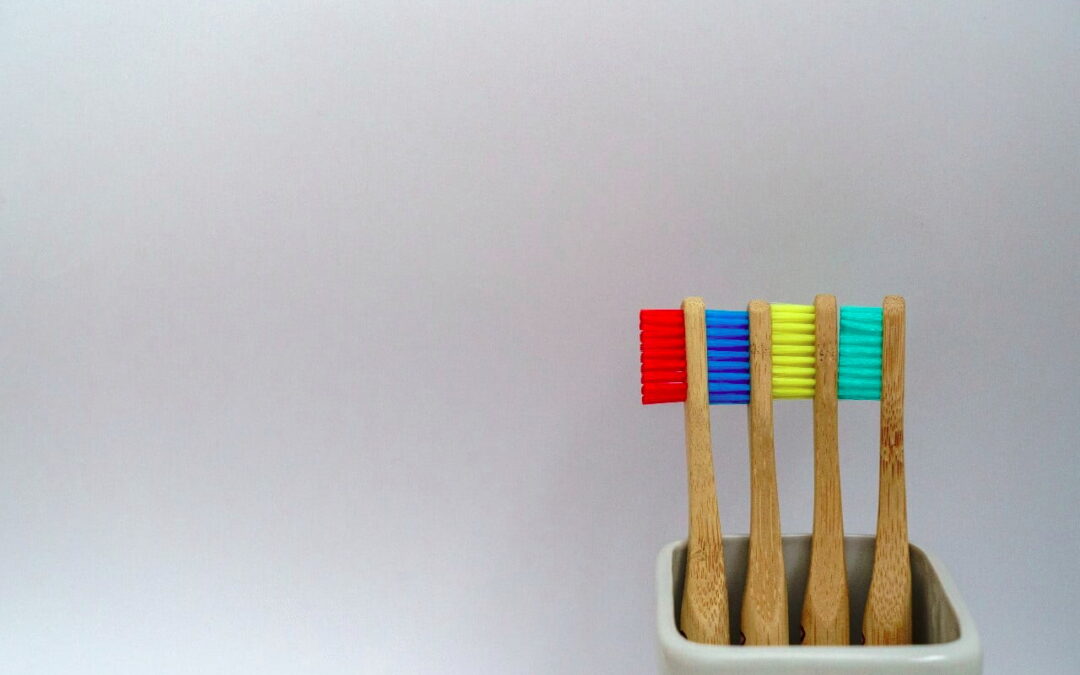We frequently, and with great passion, discuss the necessity of routine dental hygiene. Do it twice per day. Brush for two full minutes. Use fluoride toothpaste. Floss at least once a day. Drink more water and less soda and juices. Sound familiar? Of course it does; hopefully most of those directives are embedded in your brain!
Be that as it may, we don’t discuss as often how to take care of your toothbrush. Care for your toothbrush? You don’t have to love it (but when your kids love theirs, it can make life a bit easier). Still, think about it: all the bacteria, plaque, and germs in your mouth are scrubbed away with those bristles, but is it enough to do a quick rinse and shake of your toothbrush when you finish?
Let’s dig in!
Proper Storage of Toothbrush
The fact that we clean our teeth in the same room as we urinate and defecate seems normal, and while it is normal by our standards, it’s not necessarily clean. When you flush the toilet, the action sends an aerosol of microscopic particles of whatever was in the toilet, into the air. This is referred to as toilet plume, and has actually been the study of a number of research studies.
A study from 2005, “The potential spread of infection caused by aerosol contamination of surfaces after flushing a domestic toilet“, found evidence that while closing the lid of the toilet prior to flushing is helpful, it does not fully reduce the spread of toilet plume, and bacteria can be transmitted onto bathroom surfaces. This brings us succinctly around to the point of where and how you store your toothbrush.
A knee-jerk reaction may be to move your toothbrushes to a cabinet or drawer, this is understandable and logical. Unfortunately, while that may protect them from toilet plume, it isn’t terribly sanitary either because an enclosed space will make it difficult for the bristles to dry out, thereby allowing bacteria and germs to propagate. If you’ve read up on the topic already, you may see some recommendations to store your toothbrush with a cap. Again, a storage cap creates an enclosed space that will prevent your bristles from drying out and can cause bacteria to actually grow with the moisture. So, what are you supposed to do?
Toothbrushes should be stored vertically, and without touching each other. Place the toothbrush stand on the opposite side of the sink from the toilet (or further away if space allows). When you are finished brushing your teeth, rub the bristles under water to wash away visible physical matter and remaining toothpaste. Shake to remove excess water and stand to air dry.
Cleaning Your Toothbrush
Despite your new awareness of toilet plume (or perhaps due to it), and therefore your better storage arrangement for said toothbrushes, you might want to consider cleaning your toothbrush. Some google results will suggest that you put it with the silverware in your dishwasher or giving it a few minutes in the microwave, but the American Dentists Association actually recommend against those methods of cleaning. Instead, research shows that soaking your toothbrush in either three percent hydrogen peroxide or Listerine Antiseptic mouthwash reduces up to 85% of bacteria.
Do You Need a Toothbrush Sanitizer?
In the last several years, toothbrush sanitizers have become a popular item that can be found in most drugstores, Walmarts, Targets etc. Although, just because these items are readily available, do you need one?
That depends mostly on how concerned you are about the aerosol of germs in your bathroom. Despite the fact that toilet plume does exist, which is gross, unless someone in your family has acute gastroenteritis (and even then) it is unlikely to actually harm you.
Nevertheless, toothbrush sanitizers are relatively affordable. When selecting a toothbrush sanitizer, be sure to buy one that has FDA approval. Many sanitizers use UV lights and/or heat, therefore purchasing one that has met the FDA standards will ensure it’s safe to have in your home.
Moreover, it is important to take note of the distinction in meaning between to sterilize and to sanitize. To sterilize something, that means to completely eliminate all bacteria. That’s not what these devices do. We’re talking about sanitizers, which means they will reduce the presence of bacteria not remove it altogether.
When to Replace Your Toothbrush
How long have your kids been using the same toothbrush? Are the bristles worn looking and wonky? General advice is that you should be replacing toothbrushes in the house every three to four months, or sooner if the bristles look worn. It’s also a smart idea to replace a toothbrush when someone’s been sick.
Re-use Old Toothbrushes
Hold onto those old toothbrushes before you throw them in the trash. There’s actually a number of things you can use them for, once they’ve been cleaned.
Toothbrushes are excellent for cleaning grout lines in bathroom tile, cleaning the metal sliding tracks of shower doors, and other corners around the house that are a challenge to scrub. Don’t forget your jewelry box, those bristles will reach well into the grooves of brooches, rings, earrings, and bracelets.
How about art projects? Toothbrushes are surprising substitutes for craft ideas around the house or as paint brushes in several different DIY projects at home with the kids. Here are a few to jump start your brain!
It’s Time for a Checkup!
When was the last time your kids had a dental cleaning? With Thanksgiving just around the corner, the holiday events, sports activities, and school final projects are picking up the pace. Bring your kids in before the end of the month to capitalize on your yearly dental benefits, and head into the sweet season with sparkling, healthy smiles. Give us a call today, to learn which of our three locations is nearest you.


Trackbacks/Pingbacks